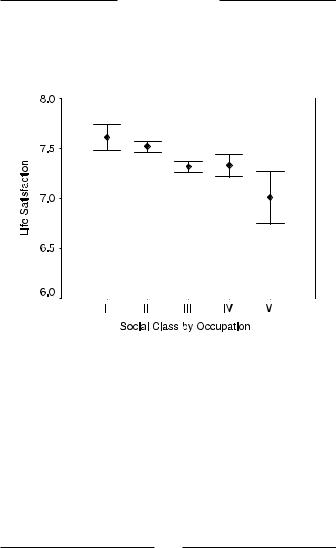
Books on Happiness / Happiness_ The Science Behind Your Smile
.pdf
BREAD AND CIRCUSES
usually seem salient enough to be the frame for our judgements.
If the happiness system exists to help us seek out the things that are best for us, then it is right that it should come very finely tuned to the possibility that things are better elsewhere. It should be constantly scanning the horizon on the lookout for a better environment, a better social network, a better mode of behaviour. And it should always have left a little space of discontent open, just in case something hoves into view which is really special. Pessimistic philosophies can exploit this little space, by drawing attention to the aspects of life that are most annoying and working them up into the whole context for decision-making. Of course, it doesn’t mean that they are wrong in their diagnosis or their remedy. But it is useful to retain a balanced perspective and a critical mind.
The happiness system has not only to identify betterlooking alternatives. It has to make us pursue them. Thus it is in its nature to identify things that look like they are associated with status, ease, sex, beauty, and other trappings of biological fitness, and tell us that if we only had those circumstances, we would be much happier. Now there may be things that make people genuinely happier, but there are also a great many things that people do that don’t make them any happier at all in
62

BREAD AND CIRCUSES
the long run. People want them, but once they have them, they become preoccupied with wanting something else. The strength of this wanting means that we are quite ready to believe that happiness would be complete if only some set of conditions or other were fulfilled.
In fact, though, people will never be completely happy, whatever their external conditions. The people you love won’t always love you back. You yourself will be divided between irreconcilable goals, like sex and companionship, ambition and comfort, money and time. Nothing will take these conflicts away. They just have to be managed. On the other hand, the human animal is supremely capable of finding pleasures under all but the most catastrophic of circumstances. People who live on the slopes of volcanoes grow grapevines, and people with tragic personal histories find ways of being reasonably happy.
This doesn’t mean that it doesn’t matter what we do. There are public policies that will genuinely improve or worsen people’s lives. There are also psychological strategies for narrowing the happiness gap, which will be discussed in a later chapter. However, the data presented in this chapter put frustrations into context. Things are seldom as bad as they seem. It is not the human condition to be always unhappy. If you are
63

BREAD AND CIRCUSES
prone to thinking that everything in life is doom and gloom, then you might want to examine whether you are making the right comparisons, or dwelling on the past or future in the wrong way. On the other hand, this life is imperfect, and total bliss is not part of its design. Any framework that claims that any time, place, or organization of people will produce perfect happiness should be peremptorily dismissed, and Utopias should be given sceptical scrutiny. It is a disservice to people like the Samoans, who faced life with as much bravery as us, to suggest that things were one jot simpler for them than they are for us. Far from being a disappointment, this conclusion is strangely liberating. It relieves us from the anxiety that someone else’s life is a paradise and ours somehow is not.
64

3
Love and work
igmund Freud is reputed to have said that the Sbasis of well-being was ‘love and work’. Freud was a happiness pessimist who had also written that the best that could be hoped for in life was ‘the trans-
formation of hysteric misery into common unhappiness’. In light of this, asking the good doctor for his prescription for good living seems a bit like, as the Nigerian proverb has it, asking a bald person for advice on your hairstyle. Nonetheless, his answer seems a reasonable one and worthy of further investigation. Which people are happier than others? Is it those with love in their lives, or fulfilling work? Is it those who earn millions, those who live a life of leisure, or those who devote themselves to a higher cause?
These are all empirical questions that psychological surveys are well capable of taking on. However, before we turn to questionnaires and correlation coefficients, it is worth considering the RIRO problem (rubbish in,
65

LOVE AND WORK
rubbish out). We saw in the previous chapter that people’s assessments of their own happiness are fickle and subject to all kinds of context effects and impression management. If they reflect nothing more than these, then surveys of who is happy will not mean very much.
As we have seen, almost everyone describes him or herself as moderately to very happy. Thus the amount of variation to work with is not very great. However, there is variation to explain, scattered around the upper end of the field (i.e. there are some people who are close to mid-point and others close to maximum). Though judgements of life satisfaction are affected by current mood state and other contextual factors, it seems, fortunately, that there is some genuine signal that is audible through this noise.
For one thing, when individuals are asked multiple times over a few months or years to report on their life satisfaction, the responses they give are rather (though not completely) self-consistent. When groups of people are surveyed, the results are even more consistent. Moreover, individuals’ own ratings correlate with ratings of their happiness given by friends and family, and also with objective measures of things like amount of smiling, and neutral observer assessments. Besides which, the patterns reported in this chapter have been
66

LOVE AND WORK
found with high consistency in multiple investigations in many countries.
Most strikingly, self-reported happiness is strongly related to health. One remarkable study examined the lives of a cohort of nuns in the USA. The nuns had written autobiographical sketches when they took holy orders. Researchers rated these for how much positive emotion they expressed. They then went on to look at the life expectancies of the sisters. This is a good natural experiment, since all nuns have diets, activity patterns, and marital and reproductive histories that are comparable to each other. It turns out that, in the quarter of the nuns who expressed most positive emotion in their sketches, 90% were still alive at age 85. In the quarter expressing least positive emotion, only 34% were still alive at that age.
This study is one of many that have found positive emotional tone to be related to better physical and mental health than unhappiness is. This is not just a correlation of two variables at a single point in time; happiness at one stage of life has also been shown to be a predictor of relative health many years later, and of responses to health shocks, like recovery times. Correlation is not causation, and none of these results proves that happiness per se causes a robustness in response to health challenges. However, the studies do show that
67

LOVE AND WORK
people’s reports of their feelings of well-being are tapping in to something that is not a mere will o’ the wisp. Whatever it is they are reporting, it is on average related to something really important—robustness, stress, coping style, social support, or whatever—that in turn relates to how long they are going to live. This is just another reason for saying that people’s feelings of happiness are worthy of study and promotion.
In sum, then, happiness assessments are subject to vagaries and fickleness. On the other hand, so is everything interesting that you want to measure. Psychologists are usually content to measure the ineffable on two conditions: one, that when you measure it repeatedly or using a slightly different technique, you get something close to what you got the first time (the reliability criterion); and two, that the measure you end up with is related to an objective outcome that is actually important (the validity criterion). Self-report measures of happiness generally pass these tests. Thus any patterns we might discover deserve to be taken seriously, especially where the surveys are large or the results replicated in different populations.
So who is happy? Here, once again we can turn to the NCDS survey that we first discussed in the previous chapter. Amongst the NCDS participants, as we saw, the average level of life satisfaction was 7.29 on a ten-point
68

LOVE AND WORK
scale. The women in the cohort reported an average of 7.34, whereas the men’s average was 7.23. This is not a large difference, but it is statistically reliable. British women of this generation are a little happier with their lot than their male peers. Is this the evidence for the crisis of the masculine role so often espoused in newspapers and magazines?
It may not be so straightforward. Many studies have found that women experience more fear and anxiety, more sadness, and particularly more of the social emotions of shame and guilt than men. Support for this is found in the NCDS in a separate part of the study where the participants were given a malaise inventory. This is a series of questions about negative feelings in life— misery, worry, irritability, worthlessness, and so on. Women scored significantly more highly than men; besides which, in the NCDS as in many other health studies, there was a higher instance of treatment for clinical depression among the women than among the men.
So how can women be both more miserable and happier? You will recall that the experience of negative emotions in life is largely independent of the experience of positive ones, and things like life satisfaction are affected by them both. Thus it may be that women experience more positive states than men, as well as
69

LOVE AND WORK
more negative ones. There are several studies that indicate that this does indeed happen. The debate about whether the extra vividness of emotion for women is in the actual experience, or in the expression (and indeed whether, in the case of emotion, these two can entirely be teased apart) goes on. What is clear is that women in some sense do experience emotion to a slightly greater intensity than men do.
Those who say that money doesn’t buy happiness don’t know where to shop, or so the saying goes. So is there evidence in the NCDS that happiness comes with affluence? One measure of socio-economic position is social class. In Britain, this has usually been assessed by ranking occupations into a five-category scheme that reflects their social standing, from Class I (professional) to Class V (unskilled and routine). Life satisfaction differs across the classes, undramatically but with high statistical reliability. The highest occupational groups average about half a point higher on the ten-point scale than those in unskilled jobs (Fig. 3.1). Note that the unemployed are not included in this scheme. Other studies have shown them to have among the lowest satisfaction scores of any social group.
What is it about being in the higher social classes that increases life satisfaction? The obvious answer would be
70

LOVE AND WORK
Fig. 3.1 Life satisfaction in contemporary Britain by social class, as defined by occupation. The classification runs from I, Professional to V, Unskilled and routine. Data from the 2000 sweep of the National Child Development Study.
71
